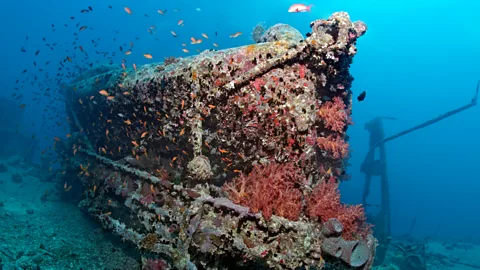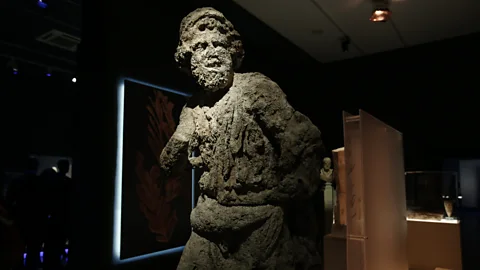How many shipwrecks are there in the world's oceans?
 Alamy
AlamyThis week UNESCO announced it has found three new shipwrecks, including two that are thousands of years old. But just how many more could be out there?
When Elias Stadiatis descended into the indigo-blue water, he had a normal day of searching for sponges ahead of him. Weighed down in a copper diving suit, surrounded by a tangle of breathing tubes, Stadiatis eventually reached the seafloor. As he squinted into the dim, he took in a haunting scene: all around were the fuzzy outlines of human body parts. As he surfaced in a pool of bubbles, he frantically informed the captain he'd found a heap of rotting corpses.
It was the spring of 1900, and Stadiatis had accidentally discovered the Antikythera shipwreck – the remains of a Roman cargo vessel that had sunk more than two millennia earlier. It soon became clear that it was not teeming with cadavers, as it first seemed, but artworks – marble sculptures and bronze statues, seasoned by thousands of years among algae, sponges and fish.
More than 100 years on, the relics at Antikythera, found off the coast of a Greek island on the edge of the Aegean Sea, are still captivating the public. But there are plenty of submerged wonders still waiting to be discovered.
Take the recent Unesco expedition to Skerki Bank, a particularly treacherous shallow reef that links the eastern and western Mediterranean. It has been heavily used for thousands of years – and in that time, it has claimed hundreds of ships. Using multibeam sonar and underwater robots, a team of scientists from eight countries mapped the seafloor in the region. This week, they announced the discovery of three new wrecks: the ghostly remains of boats dating to the 1st Century BC, 2nd Century AD, and 19th or 20th Century.
And according to Unesco's estimates there could be many, many more undiscovered wrecks still to be found beneath the waves of the world's oceans.
A hidden record
The oldest known boat was found by accident while a motorway was being built in The Netherlands – a wooden canoe crafted over 10,000 years ago. But there's circumstantial evidence it all started far earlier, with humans suddenly appearing on the other side of vast bodies of water. Around 50,000 years ago, it's thought that a group of hunter-gatherers from Southeast Asia must have crossed a band of islands hundreds of miles long, because soon afterwards the first Australian Aboriginals turned up at Lake Mungo in New South Wales.
And where there are sea crossings, there are wrecks. Today the world's oceans are scattered with the debris of millennia of trade, war and exploration – pirate ships loaded with silver, cargo boats along the maritime Silk Road, luxury royal craft that disappeared along with future kings, ancient fishing vessels, modern destroyers and submarines, 19th-Century whalers, and vast passenger liners like the Titanic. Like long-forgotten time capsules, these ships have captivated archaeologists and filled museums around the globe with ancient wonders – including a mysterious astronomical clock from Antikythera, which some experts view as the earliest computer.
So, how many are there in total – and how many still remain hidden in the depths of the ocean?
 Getty Images
Getty ImagesThere are several databases of the world's shipwrecks, each of which has a slightly different estimate for the total number that has been found. The online service wreck site has a catalogue of 209,640 boats known to have sunk, 179,110 of which have a known location. The Global Maritime Wrecks Database (GMWD), on the other hand, contains the records of more than 250,000 sunken vessels, though some of these still haven't been found.
According to one estimate, around 15,000 ships sank during World War Two alone – there are forgotten battleships and tankers strewn from the Pacific to the Atlantic, gradually bleeding oil, chemicals and heavy metals into the surrounding water as they decay.
In fact, it's thought the shipwrecks that have been documented only represent a small fraction of the total. According to an analysis by Unesco, there are over three million resting undiscovered in the world's oceans.
These elusive relics are unlikely to be evenly distributed. As you would expect, there are a number of wreck hotspots – maritime graveyards along popular or perilous routes, which have proved to be fertile hunting grounds in the past.
This includes Skerki Bank, as well as the Fourni archipelago, also in the Mediterranean, where 58 ships have been discovered so far – including 23 in just 22 days in 2015. While Fourni archipelago wasn't considered particularly dangerous, it was commonly used as an anchorage point, so it's thought the sheer volume of traffic led to a high concentration of vessels coming to rest there.
A treasure trove
Not only does this hidden cache of as-yet-undiscovered wrecks contain fascinating details of how people once lived – and possible hazards for the future – it can also contain mind-boggling riches. And this can be problematic.
At around 7pm on 8 June 1708, a powerful explosion echoed across the Caribbean Sea off the coast of Colombia. It was the last battle cry of San José, a galleon that had set sail from Spain two years earlier. The boat was part of the Spanish treasure fleet – a convoy of boats, loaded with sugar, spices, precious metals, and other goods, transported between Spain and its territories in the Americas.
As the flagship, San José was carrying a mother-lode – chests of silver, emeralds, and an enormous quantity of gold doubloons. But it came to a violent end during a confrontation with a British ship. After hours of battle, its stores of gunpowder took a hit, and it sank almost immediately – vanishing into the ocean along with nearly 600 crew members.
Over 300 years later, in 2015, the Colombian navy finally identified its broken remains, along with cannons, ceramics, and coins. In all, its cargo is worth an estimated $17bn (£13.5bn). But the find immediately led to a bitter battle over who owns the wreck. Now there are concerns that the archaeological site will be plundered rather than protected.
A golden age
These kinds of disputes could soon become a lot more common.
In the past, many shipwrecks were found in relatively shallow waters, sometimes by accident, as fishermen, scientists or treasure-hunters explored the seabed around the world's coastlines. But with access to sophisticated submersibles, modern camera equipment and new sonar technologies, finding deeper shipwrecks has never been so easy.
It's now possible to build up a picture of the ocean floor even in the deepest water – in 2019, researchers discovered the resting place of the destroyer USS Johnston 6km (3.7 miles) deep in the Philippine Trench. (Read more from BBC Future about how the world's deepest shipwreck was found.) Then earlier this year, scientists built a digital twin of the Titanic in three dimensions, based on surveys of the wreck on the Atlantic Ocean floor.
As a result, the oceans are giving up their secrets at an unprecedented rate.Just as the use of sonar and GPS tracking has transformed fishing - allowing whole shoals of once-elusive tuna to be identified in the open ocean - anyone can now use these same technologies to find shipwrecks in locations never previously suspected.
But for now, there are still plenty of undiscovered wrecks lurking in the deep – including some of the most famous. Take the Waratah, a gigantic passenger ship often compared to the Titanic. She set sail from Durban to Cape Town on 26 July 1909 with 211 passengers on board, then vanished. To this day, no one knows what happened or where exactly the behemoth sank: despite at least nine expeditions to search for her remains, none have ever been found.
Who knows what will turn up next. Only one thing is certain: it won't be long until we find out.
--